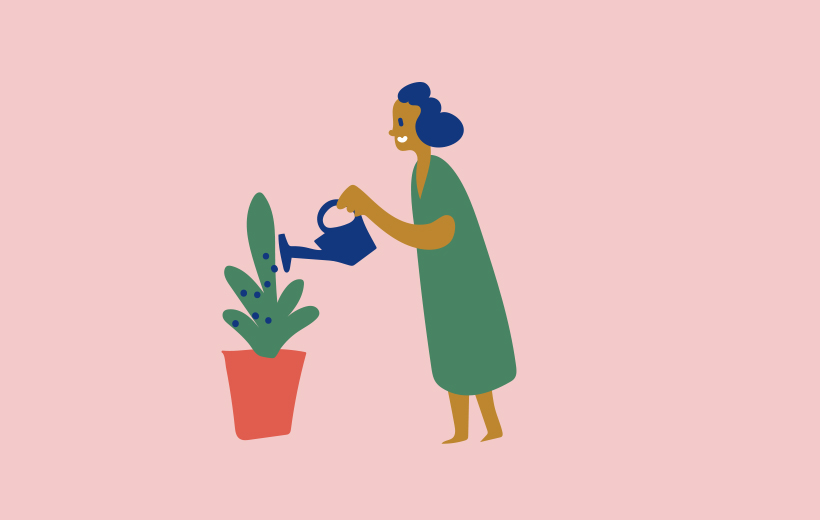Should You Meditate with Your Eyes Open or Closed?
By Tergar Meditation Community • 5 min read
By Tergar Meditation Community • 5 min read
As a beginner, if keeping your eyes open during meditation is too distracting, it’s fine to close them. And, as your practice progresses, you may encounter particular types of meditation that involve visualization, in which case, having your eyes closed can be helpful. Generally, though, in Mingyur Rinpoche’s tradition, you are encouraged to meditate with open eyes. If you’re unable to do so at the outset, it’s recommended that you practice it a little at a time until you find it comfortable.

It might help to know that “eyes open” doesn’t mean staring or bugging out your eyeballs, trying not to blink. It can actually feel very relaxed. If having them open irritates you, check in with how they’re open. You can even touch your face to see if the muscles around your eyebrows are tense, and if they are, release them. Continue to tune in like this until meditating with eyes open eventually feels natural and comfortable.
Through the practice of meditation, we can come to experience the quality of authentic inner joy anytime, anyplace, 24 hours a day, 365 days a year. This may sound like an impossibly lofty goal, but it’s achievable. How? By bringing awareness to everything we do. “Everything we do” includes the nitty-gritty of dealing with the people, places, and things that make up our world: staying late at work, driving our kids to school and our pets to the vet, taking the bus, and shopping for groceries. We need our eyes open for all this stuff, so it goes without saying that meditating on the cushion with our eyes open will make it all the more natural to do so off the cushion.
There are other reasons to keep your eyes open. Meditating with your eyes closed can give rise to experiences specific to having one’s eyes closed in general . . . a certain dreamy quality that might seduce you into thinking, “Okay, now I’m meditating.” Quite unconsciously, you might then start dividing your experience between being on the cushion with these lovely, dreamy experiences, and being off the cushion — also known as everything else. It’s “meditation” life versus “everything else” life . . . and then, bam! You have unwittingly turned meditation into an instrument for further splitting your view into what you do and don’t like, positive and negative, hope and fear, good and bad — when actually, what we’re meant to discover in meditation is that awareness can handle and hold everything equally, which is the key to inner joy.
In the vast space of awareness, hope and fear are just two galaxies among countless trillions. Within awareness, you can touch into a deep, grounded, stable sense of well-being, of sanity. In order to be able to experience this calm sanity throughout the day, you need to be able to bring awareness to your life in real time. It’s not something you need to create by closing your eyes and digging deep inside; you can connect with it at any moment. To deal with what life dishes out, you need to be fully available to reality. After all, should you get pulled over by a police officer, it’s not as though you can say, “Excuse me, officer, I need to close my eyes for a few minutes and meditate.” The idea is to be present and bring awareness to every situation.
“Wherever you are and whatever you are doing, pause from time to time and relax your mind. You don’t have to change anything about your experience. You can let thoughts and feelings come and go freely, and leave your senses wide open. Make friends with your experience and see if you can notice the spacious awareness that is with you all the time. Everything you ever wanted is right here in this present moment of awareness.”
– Mingyur Rinpoche –
Try to apply this walking guided meditation by Tergar Instructor Myoshin Kelley in your everyday life with your eyes open.
Do you want to try meditation, but don’t know how to start? This free course is specially designed for beginners, and takes only a week to complete.

Tergar Meditation Community supports individuals, practice groups, and meditation communities around the world in learning to live with awareness, compassion, and wisdom. Grounded in the Tibetan Buddhist lineage of our guiding teacher, Yongey Mingyur Rinpoche, our online and in-person programs are accessible to people of all cultures and faiths, and support a lifelong path toward the application of these principles in everyday life.

As we know, personal relationships can get stuck in an unhealthy pattern. Someone raises their voice in anger at you, and even though you don’t want to, you react by lashing out with cruel words. Of course, you want to change this reaction. To do this, you need to rely…

When you first begin a meditation practice, you might have a rather pleasant experience – a sense of clarity, or a more settled mind, for instance. However, once you’ve tried meditation a few times, a flurry of thoughts might start popping up – or even a real overload of thoughts…

"Trying harder and putting in that extra bit of exertion was so counterproductive!"
If you enjoyed reading our articles, please join our mailing list and we’ll send you our news and latest pieces.
